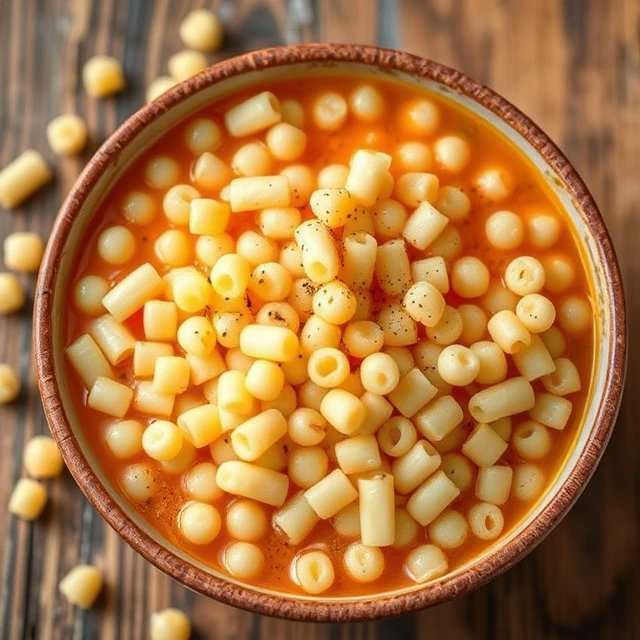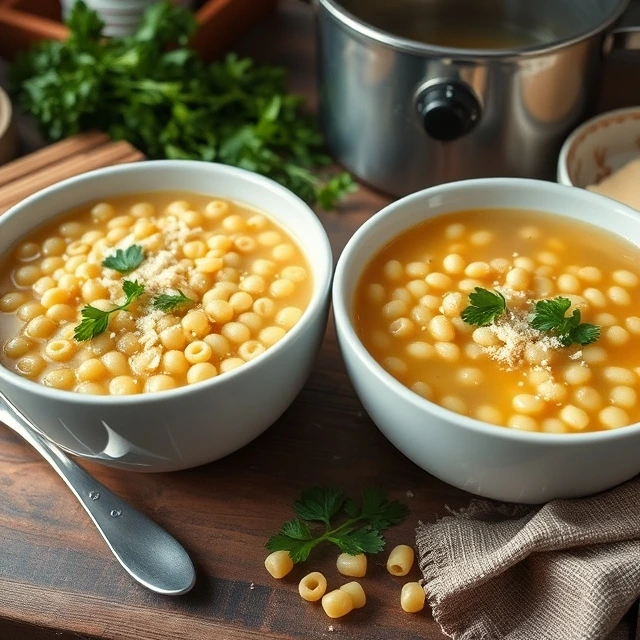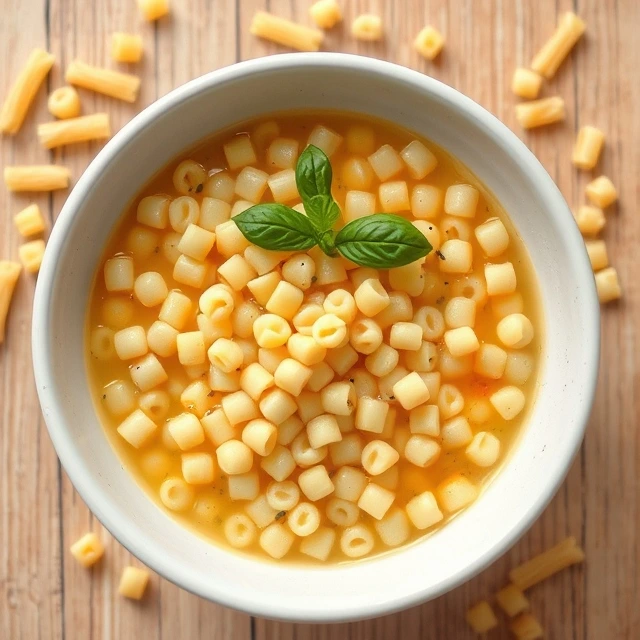When it gets cold and the days get shorter, a warm bowl of Italian pastina soup is perfect. It’s like a hug in a bowl. This dish, known as “Italian penicillin,” brings back memories of childhood. It was the go-to remedy for a cold winter day.
Looking for a creamy or brothy pastina soup? This recipe lets you choose. It’s quick, ready in just 25 minutes. It’s ideal for those who need a break from a busy day.
Key Takeaways
- Pastina soup is a classic Italian comfort food ready in just 25 minutes
- The dish can be prepared in a variety of ways, including creamy, brothy, and veggie-packed versions
- Pastina soup is not only easy to make but also nutritious and kid-friendly
- The recipe can be customized with different protein options, such as chicken or eggs
- The soup can be stored in the fridge for up to 5 days or frozen for up to 4 months
Understanding Pastina: The Tiny Italian Pasta with Big Comfort
Pastina, the small Italian pasta, is loved by many Italian families. These tiny, star-shaped pasta pieces, known as stelline, are a favorite first food for Italian babies. They are easy to digest and bring comfort.
Its popularity has given it the nickname “Italian penicillin.” It’s often given to those who need a little extra care. It’s a soothing and restorative food.
Origins of Pastina in Italian Cuisine
Pastina’s history goes back to Italy’s rich culinary traditions. It’s been a key ingredient in italian cuisine for centuries. The name “pastina” means “little pasta” in Italian.
It’s a comfort food that has nourished many Italians. It’s simple yet versatile, making it a favorite in Italian families.
Why Pastina is Called “Italian Penicillin”
Pastina soup is known as “Italian penicillin” for its healing effects. It’s a go-to when feeling sick. A warm bowl of pastina pasta in broth, with a soft-cooked egg or Parmesan cheese, is a classic remedy.
This dish is a staple in italian childhood memories. It’s a comforting treat that brings back happy times.
“Pastina is the ultimate comfort food, transporting me back to my grandmother’s kitchen and the warm embrace of a childhood filled with love and tradition.” – Isabella, Italian-American chef
Essential Ingredients for the Perfect Pastina Soup Recipe
Making the ultimate pastina soup is all about simple ingredients. At its core, it has tiny pasta shapes like pastina in a tasty broth. You can choose between chicken broth or vegetable broth for a delicious base.
Aromatics like onions, carrots, and celery are sautéed for flavor. Garlic is also key, adding its unique smell. A sprinkle of Parmesan cheese on top adds a creamy, savory touch.
The beauty of pastina soup is its flexibility. You can add eggs for richness, milk for creaminess, or vegetables for nutrition. This lets you tailor the soup to your liking.
Whether you want a classic or a nutritious version, focus on quality flavorful ingredients. This way, you’ll make a dish that warms your heart and delights your taste buds.
“Pastina soup is a hug in a bowl, made with simple, wholesome ingredients that come together to create a truly nourishing and satisfying meal.”
| Ingredient | Quantity |
|---|---|
| Reduced-sodium chicken broth | 5 cups |
| Pastina (star-shaped pasta) | 1 cup |
| Parmesan cheese | Freshly grated |
With these pastina soup ingredients, you’re ready to make a comforting, tasty meal for any time.
The Basic Cooking Method: Creating Your Base Broth
Making a tasty base is key for a great homemade pastina soup. Begin by boiling a mix of chopped veggies – onions, carrots, celery, and garlic – in 8 cups of broth for 20 minutes. This step adds depth and complexity to the broth.
Preparing the Vegetable Base
After the veggies simmer, strain them from the broth. Blend them with a little water until smooth. This makes the broth creamy and adds sweetness to the pastina in broth.
Straining and Blending Techniques
Put the blended veggies back into the broth. Bring it to a boil again. This mix makes a creamy yet light base, ideal for your easy pastina recipe.
Adding the Pastina
Now, add the pastina! Carefully add it to the boiling broth. Cook for 5-6 minutes, stirring often to avoid sticking. The whole process takes 25-30 minutes, making a nourishing one-pot meal.
“The recipe is rated 5 out of 5 stars by Julia and Jennifer, indicating high satisfaction with the outcome.”
Creamy vs. Brothy: Two Classic Pastina Styles
There are two main ways to enjoy pastina soup: creamy or brothy. The creamy version has less liquid and often includes milk or cream. This makes it thick and creamy, like risotto. The brothy version, on the other hand, has more liquid, making it lighter.
To make a creamy pastina soup, use 2 cups of liquid for every 1/2 cup of pasta. This gives it a smooth, velvety feel. For a brothy pastina soup, just use 4 cups of liquid.
You can add different ingredients to both pastina soup variations to make them your own. Try adding eggs for a richer texture or top it with Parmesan cheese and herbs for a true Italian pastina recipes taste.
Choosing between creamy or brothy, pastina soup is a comforting dish for any time of year. It warms your heart and satisfies your taste buds, no matter the texture you prefer.
Secret Veggie Pastina: A Nutritious Twist
Make your pastina soup better by adding a secret veggie twist. This makes the soup not only healthier but also creamier.
Choosing the Right Vegetables
Choosing the right veggies is key for a healthy “hidden veggie” pastina soup. Simmer carrots, celery, onion, or cauliflower in broth until they’re soft. Then, blend them until smooth to make a flavorful stock for your pastina.
Blending for Smoothness
Blending is the secret to a smooth, creamy pastina soup. Blend the cooked veggies in broth until it’s silky. This makes the soup thick and creamy, great for those who don’t like veggies.
Customize your pastina soup with vegetables to meet your needs. Try different veggies to find your favorite hidden veggie soup recipe.
| Ingredient | Amount |
|---|---|
| Carrots | 2 cups, chopped |
| Celery | 1 cup, chopped |
| Onion | 1 medium, diced |
| Chicken Broth | 5 cups |
| Stelline Pasta (or other small pasta) | 7 ounces |
| Fresh Parsley | 2 tablespoons, chopped |
| Spinach | 2 cups, chopped |
Blending veggies into the broth makes a creamy, nutritious pastina recipe. You can adjust the veggies and seasonings to enjoy a comforting soup.

Adding Protein: Egg and Chicken Variations
Make your pastina soup better by adding protein. For a creamy twist, mix an egg with Parmesan and slowly add it to the hot soup. This makes the soup silky and velvety, covering the tiny noodles well.
For a heartier meal, try adding shredded or cubed cooked chicken. Just put the chicken in the boiling broth with the pastina. This chicken pastina soup increases protein and flavor, making your soup more filling and tasty.
Both the pastina soup with egg and the protein-rich pastina recipes with chicken are great choices. The egg version is creamy and luxurious. The chicken version is more filling and flavorful. Try these easy additions to make your pastina soup better.
| Pastina Soup with Egg | Chicken Pastina Soup |
|---|---|
| Preparation Time: 10 minutes | Preparation Time: 30 minutes |
| Ingredients: Water, chicken bouillon, egg, pastina | Ingredients: Chicken bone broth, pastina, cooked chicken, olive oil, onion, garlic, ginger, seasonings |
| Servings: 2 bowls | Servings: 6 bowls |
| Calories per Serving: 58 kcal | Calories per Serving: 289 kcal |
| Freezing Tip: Can be frozen for up to 3 months, but best enjoyed fresh | Freezing Tip: Can be stored in the freezer for 3-4 months |
Both the pastina soup with egg and chicken pastina soup are comforting and packed with protein. They are sure to please your taste buds.
Flavor Enhancers: Parmesan, Herbs, and Seasonings
Make your pastina soup even better with tasty garnishes and seasonings. The classic Italian way is to add grated parmesan cheese, chopped parsley, and a bit of olive oil. For more flavor, simmer the broth with a bay leaf and a Parmesan rind. This adds a deep, savory taste.
Want to try something new? Add other hard cheeses like pecorino romano or asiago for a stronger cheese flavor. Fresh herbs like basil, thyme, or rosemary can also make the soup smell and taste better. A squeeze of lemon juice adds a nice brightness. Don’t forget to adjust the seasonings, especially salt and black pepper, to get the flavor just right.
Traditional Italian Garnishes
- Grated Parmesan cheese
- Chopped fresh parsley
- Drizzle of olive oil
Modern Flavor Additions
- Different hard cheeses (pecorino romano, asiago)
- Fresh herbs (basil, thyme, rosemary)
- Lemon juice for brightness
Try out different pastina soup seasonings, Italian herbs, parmesan cheese, and other flavor enhancers to make your soup your own. Pastina is very versatile, so let your creativity run wild.
Kid-Friendly Pastina Soup Options
Pastina soup is great for kids, meeting their taste and dietary needs. It’s perfect for babies, toddlers, and young kids. Use mild flavors, smooth textures, and fun shapes to make it appealing.
Tailoring for Younger Eaters
For babies and toddlers, start with a gentle broth. Avoid strong or spicy seasonings. Choose small pasta shapes like star-shaped pastina or ditalini for easy handling.
Add a bit of milk to make the soup creamy. This texture is often preferred by younger children.
Sneaking in Veggies
Use the “secret veggie” method to add nutrients to pastina soup. Blend in pureed veggies like carrots, sweet potatoes, or spinach. This way, kids get extra veggies without knowing it.
Alphabet Pasta for Fun
Try alphabet-shaped pastina or other fun shapes like stars or hearts. It makes mealtime fun and interactive. Kids will enjoy trying to spell out their names or favorite words.
Always check the soup’s temperature before serving it to young children. This ensures it’s safe and comfortable for them. By adjusting flavors, textures, and shapes, you can make a soup that kids will love.
| Prep Time | Cook Time | Total Time | Calories | Servings |
|---|---|---|---|---|
| 10 minutes | 20 minutes | 30 minutes | 289 kcal | 4-6 |
Here are the key ingredients for a kid-friendly pastina soup:
- 1 quart reduced-sodium chicken broth
- 1 cup pastina
- 1 cup frozen petite peas
- 1/2 cup grated Parmesan cheese
- 1 tablespoon fresh lemon zest (optional)
- Salt and pepper to taste
For extra protein and flavor, add cooked chicken or chicken meatballs. Top with fresh herbs or black pepper for extra taste.
Storage Tips and Reheating Guidelines
Pastina soup is a comforting and delicious dish. But, what about storing and reheating leftovers? Don’t worry, we’ve got you covered. You can store pastina soup in an airtight container in the fridge for up to 3 days.
However, remember that the pasta will soak up more liquid over time. So, you might need to add more broth or water when reheating. This will help you get the right consistency.
When reheating your leftover pastina soup, the best way is to gently heat it on the stovetop. Just put the soup in a small saucepan and heat it over medium. Stir it occasionally until it’s hot and steaming.
You can also reheat the soup in the microwave. But, make sure to stir it often to heat it evenly.
One important note: don’t freeze pastina soup. The pasta can become mushy and unappealing when thawed. Instead, freeze the broth separately and cook fresh pastina when you’re ready to serve. This way, you can enjoy the soup’s comforting flavors anytime, without losing the texture.


